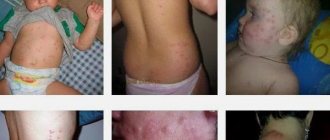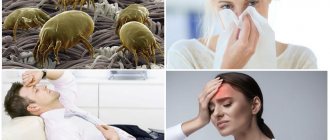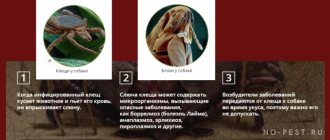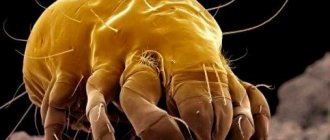There can be many different insects living in your home that cause harm through their vital activity. Among them are linen mites that feed on human blood, leaving an unpleasant mark on the skin. It is possible to fight against linen mites, and now there are a number of effective methods by which these parasites can be easily removed from the house completely.
Next, we will look in detail at the various features of these bloodsuckers, the harm they cause and methods of control. Clothes mites have small dimensions. Their average size is no more than 8 mm, while males are smaller than females. Ticks have a yellow, brown or red tint. It depends on how saturated the tick is with human blood at the moment. It is interesting that these parasites not only have a trunk for easily piercing the skin and sucking blood, but also a special set of jaws, which greatly helps them in feeding.
You can learn more about bed bugs here.
A small tick moves quite freely on a variety of surfaces and quickly hides from humans, even though it has no wings at all. Their low weight and the ability of small notches on their legs to cling to almost anything allows them to move quite freely both on the walls and on the ceiling.
Causes of ticks in the house
The main way to bring parasites into the house is through clothing. There are a lot of habitats for ticks: these can be seats in public transport, armchairs and chairs in public places, any soft, pile and textile surfaces with which a person comes into contact. A person brings them into the house on his clothes. The main time is spring and summer, when the air temperature rises to 18 degrees.
Pests can appear in places where dust accumulates and in hard-to-reach places.
Once inside a house, dust mites quickly begin to multiply in conditions favorable to them. They take root especially easily in beds and furniture upholstery, since the temperature and humidity in them are ideal for living, and dust and particles of human skin are an excellent source of food.
Blankets and pillows with long piles are also common sites for linen mites, as they are less likely to be washed.
Signs of the development of borreliosis
This disease is diagnosed more often than encephalitis. The disease is extremely dangerous and very often occurs in a latent form. In chronic forms it can lead to disability. The incubation period can last from several days to a month. The process of formation of borreliosis is divided into several stages of development:
- The first stage is a localized flow. A typical sign is a circular redness on the skin. The site of the tick bite, as the disease progresses, increases in diameter, especially its peripheral edges, from 2 cm at the beginning to 10 cm or more at the end. The edges of the skin at the epicenter of the lesion are slightly elevated in comparison with healthy areas. In the center, the skin becomes bluish, the immediate area of the bite is covered with a scab, and then a scar forms in its place. Lasts about 3 weeks, then slowly disappears.
- The second stage is disseminated, or, as it is also called, widespread. Symptoms begin to appear several months after the bite with central nervous system disorders, damage to the heart and joints, and pain in muscle tissue. Arthritis, encephalitis, and myocarditis occur.
- The third stage is chronic. Formed in the complete absence of treatment. At this stage, rapid damage to the central nervous system occurs with polyarthritis, multiple sclerosis, skin atrophy and other symptoms.
The prognosis is favorable with timely and correct treatment. The transition of the disease to a chronic form can lead to disability.
Important! The complications of this disease are very severe; they almost completely deprive a person of a full, normal life. After a parasite bite, it is vital to donate blood for testing.
In the early stages, the disease is very easy to treat.
Bites and symptoms of bed mites
Unlike bed bugs, the appearance of mites may go unnoticed because there are no marks left on the body from their bites, but due to the reaction to their secretions, red spots may appear on the body. Bed tick bites on a person in the photo look frightening precisely because of the allergic reactions that appear; if there is no tendency to allergies, then they may not appear.
Linen mites can negatively affect a person’s well-being by disrupting sleep and well-being.
Signs of ticks in the house:
- runny nose without a cold;
- sneezing;
- rarely - fever without other symptoms;
- inflammation of the mucous membranes of the eyes and nose;
- rashes and redness on the skin that have clear boundaries and are firm to the touch.
Ticks bite humans very rarely; the greatest danger from such a parasite is the skin’s reaction to the creature itself and its feces.
What harm do they cause to humans?
Since bed mites do not feed on human blood and do not leave bites on the skin, when present in the house in minimal quantities they do not cause significant harm. But the danger increases in direct proportion to the increase in the population indoors. The fact is that bed mite feces and the chitinous cover shed during molting contain a strong allergen that can cause acute painful reactions in some people.
One individual defecates about 25 times a day.
First of all, we are talking about manifestations from the respiratory system. Doctors say that inhaling the feces and chitin of dust mites, which include bed mites, is one of the most common causes of asthma. Skin manifestations are also observed - the formation of bumps and scratches, causing severe itching. This brings emotional discomfort to a person. Constant proximity can lead to chronic irritability or insomnia. Therefore, the destruction of bed mites should begin immediately after signs of their presence in the rooms appear.
How to get rid of bed mites
Despite the fact that ticks live in almost every home, they can and should be combated so that their number does not exceed the level that is safe for health. If you notice bed tick bites on yourself, as in the photo, or other symptoms, you need to determine how to get rid of them. Simply laying down clean linen or a blanket is not enough; more serious treatment is required. This can be done using special industrial preparations or folk remedies.
If signs of a laundry mite appear, one of the necessary ways to treat an allergic reaction is to completely eliminate the pest.
Drugs
- Allergof spray – fights not only mites, but also their secretions;
- Milbiol aerosol – suitable for treating mattresses, pillows and textiles;
- Easy Air – spray for complex effects, suitable for all surfaces;
- Dani Earth – suitable for textile products, effective against parasites in mattresses, sofa upholstery and pillows;
- Tsifox is an effective and potent drug, but requires special attention due to severe toxicity;
- All Rug – shampoo for wet cleaning.
How long does the parasite crawl on the body before it bites?
Depending on the location on the human body, from the moment of engagement to the bite, a tick can crawl from 40 minutes to several hours. First of all, the availability of clothing affects the speed. It takes the parasite considerable time to penetrate under it. Then, depending on the place of penetration, the tick will move to the optimal places for suction. Usually it takes the parasite several hours to do everything.
If you take a short walk through the forest in clothing covering bare areas of skin, you can detect the arachnid even before the bite, simply by examining the body and clothing. It is also worth remembering that a tick can pursue its victim for some time, so inspecting clothing upon arrival home is mandatory. He can sit with his clothes removed for up to 30 minutes, after which he begins to move around the apartment in search of a more vulnerable victim, for example, a pet or a child.
It should be remembered that in unfavorable conditions in a car or apartment, a tick can live for quite a long time: up to eight months. Since the conditions for the development of tick offspring are unsuitable, they will simply die. If there are cats and dogs in the house, then they usually become the next victims. Having attached itself to the pet’s body and having had enough of its fill, the tick can fall off when the animal is on a walk and return to its natural habitat.
Folk methods of struggle
Without resorting to serious chemicals, you can successfully control pests.
Unlike chemical exposure, traditional methods can eliminate laundry pests without harm to humans.
- A solution of table salt is an excellent remedy. To do this, you need to dilute 200 grams of ordinary salt in a liter of warm water and apply it to the surface using a spray bottle.
- Dilute 50 grams in a liter of warm water. finely grated laundry soap, add 100 ml of ammonia, treat surfaces and textiles with the solution.
- Tansy and wild rosemary are herbs that work well against ticks. You can place bags of dried plants under mattresses and pillows and upholstery, or you can treat them with a decoction.
- A steamer or steam generator will be a great help in fighting pests; parasites cannot withstand high temperatures and die.
Maintaining regular room hygiene will reduce the risk of parasites.
Where do they live?
Pests prefer to roam around rooms on human clothes. So their habitat extends beyond the bed and is replenished with other places in the house. Ticks cling with their limbs to curtains, carpets, fur toys and other objects. In these places they feel at ease and begin to feed on what they did before - dust, dandruff and dead skin cells. In small clusters, a person carries and scatters parasites where he is. Research data says that within 7 days, approximately 1 gram of the epidermis dies in a person, which falls everywhere. This is where you can find parasites.
Prevention
To avoid turning your home into a habitat for a colony of parasites, you must adhere to a few simple rules:
- do not enter living quarters in street clothes and, especially, do not sit on the bed in them and, if possible, wash them immediately;
- do wet cleaning daily and regularly clean with a vacuum cleaner, not forgetting hard-to-reach places where dust accumulates;
- regularly clean curtains, bedspreads and carpets, and, if possible, abandon textile products or replace them with synthetic ones;
- regular treatment of floors and furniture surfaces with disinfectants;
- frequent steaming of bedspreads, upholstery, soft toys;
- regular washing and combing of pets, daily removal of hair from the floor and furniture;
- in winter, carpets, pillows and blankets can be taken out onto the balcony or outside.
Sub-zero temperatures are no less destructive for pests than heat.
The use of such simple methods can not only reduce the number of linen mites, but also prevent the formation of other harmful parasites.
Prevention and timely destruction of household pests is much more effective and simpler than treating the consequences of the appearance of parasites in the house, therefore it is recommended that regular sanitary treatment of rooms, timely dry cleaning of textile surfaces and treatment of bed mattresses and pillows will significantly reduce the threat of diseases that can be caused by insects.
It is necessary to be attentive to the regular change of bed linen, in which parasites most often appear.
Types of dangerous fleas
Types of fleas that are potentially dangerous to humans:
- Human. These insects are one of the largest representatives of the flea family. Their body length is about 4 mm, and they are capable of jumping an impressive distance - up to 0.5 meters. These insects themselves do not live on humans, but only use them as a food source. The larvae of human fleas live and feed in places where food waste accumulates.
- Rat. Mice and rats are very frequent guests in human homes. Rat flea bites are a rather rare phenomenon, which often occurs in places where rodents gather. Rat fleas are very dangerous for humans, as they can carry more than several hundred pathogens, including bubonic plague.
- Canine. Dogs are loyal friends who are in constant and close contact with humans. That's why people are most often bitten. These creatures are very secretive and can live unnoticed on even the most well-groomed domestic dog for years. Moreover, during walks, the dog comes into contact with its relatives and simply with various sources of possible infection.
- Feline. These fleas are also one of the most common fleas that bite humans. Usually they do not pose any particular danger and bite people very rarely, content with cat blood. Flea bites on humans are less painful and go away faster, but do not forget that cats themselves are carriers of many diseases.
- Rabbit. The most aggressive and bloodthirsty of all. They can live not only on rabbits, but also on poultry and wild animals. Among poultry, they most often live on chickens. Wounds after chicken flea bites on humans hurt for a long time and do not heal.
It is very difficult to catch and neutralize the pest - their small size and high mobility allow these insects to quickly and easily escape from danger. In addition, by nature they have another protective feature - a hard chitinous shell, which protects the parasite’s body from various physical damage. A flea bite can be identified based on many symptoms.
Habitats
At home, ticks most often settle in beds. The main reason is the availability of food. Bed pests feed on particles of exfoliated skin and sweat. Optimal living conditions are warmth, humidity, and the absence of bright sunlight. In a person’s bed, all these conditions are met.
On a note!
Bed mites, when multiplying rapidly, can settle in other places in an apartment or house, hence the other names of parasites - sofa, mattress, furniture, dust.
Mattress mites settle in furniture, soft toys, interior items, and remain on any surface where a large layer of dust accumulates. It's safe to say that furniture mites are everywhere, always and everywhere. The ideal place is an unmade bed, an old mattress, feather pillows, unwashed bedding with particles of dandruff, skin, and sweat.
Bed or dust mites











